
As an avid Tolkienite, I often find myself lost in the lands of Middle-earth, be it in the books, the movies or the games. I was a big fan of Middle-earth: Shadow of Mordor and sunk many hours into that game. I still play it on occasion, just to torment my nemesis Bolg a bit more. So when Middle-earth: Shadow of War was announced, I got very excited. A sequel to one of the best Lord of the Rings games ever made? Hot damn! Yes, please! Now here we are, with the controller set aside, many hours on the clock and questions abound. Is it good? Is it bad? Did that one thing that you all know I’ll have to talk about ruin the game entirely? Well, I’ve been there and back again, so let me tell you my tale.
My world is changed. I feel it in the water. I feel it in the earth. I smell it in the air, though that might be because I should probably get a fan in my games room. It’s not often that a diehard Tolkienite experiences something that genuinely tickles their fan-bone. I spent a lot of time playing Shadow of War, folks, and I mean A LOT. This game consumed me, like Gollum and his precious. Despite being non-canon, Middle-earth: Shadow of War (and Mordor before it, just to be fair) covered every aspect of what I would look for in a Tolkien story, while still presenting an engaging game and story all of its own.
Talion and Celebrimbor, the ancient elven Wraith living within him like some cheapskate roommate, have just forged what they call the New Ring. I guess marketing is a lot simpler in Middle-earth. Nine rings for men, doomed to die? Well now try New Ring! Fresh new look, same great power! Anyway. Just as powerful as the One Ring created by Sauron, this ring is free of evil and ready to help our heroes alive and dead in their quest against the dark lord. After a quick recap of Shadow of Mordor resulting in the capture of Celebrimbor, you navigate a short crash course on the combat and movement while you seek him out. Then the story hits hard, a big bloody spider shows up and gets all sexy, things get confusing, and Talion gets thrust into this new game with nothing but his swords, his ghost buddy back in his head, but no New Ring. As far as narratives go, it’s a hell of a way to introduce you to the main players, and it works rather well in setting up the urgency of the first act.
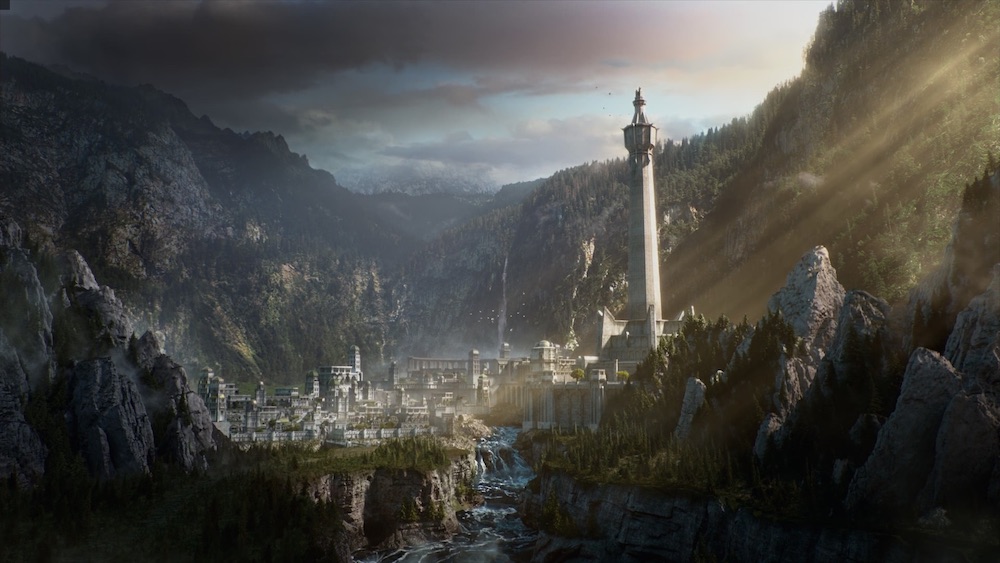
“It was only AFTER we moved from Minas Tirith that they told us how bad our neighbors were…”
Emerging from the caves of Tu-to-rial, the game wastes no time in flexing its graphical muscles, showing off one of the coolest sights I’ve seen in a game in a long while. Cradled within some mountains, rising above a lush green forested valley, the besieged city of Minas Ithil lay, the last bastion of men in Mordor, where you will be spending the majority of Act One. This place is just one of the regions you can visit, in case you didn’t know. There are more, each equally impressive, each full of quests, challenges and collectables and entire legions to terrorise.
After I finally stopped ogling the scenery, I encountered my first orcs and the Nemesis system. If I had reviewed Shadow of Mordor, I’d have said Nemesis was brilliant, like everyone else did. Here, though, it’s even better. The personalities that emerge as a result of it are the major highlight of this game. Quite often I found myself lurking in some bushes or atop a crumbling wall, just listening to the banter back and forth between these war-mongering agents of evil. One thing that these games do better than the films ever did is give the armies of Sauron a personality. The orcs of Mordor aren’t just bloodthirsty, man-flesh craving mindless monsters hell-bent on conquest. Well, okay, they are that, but they’re also funny, stupid and scary, all in different ways. Enough eavesdropping, though. I’m not Samwise Gamgee. It was time to get down to business.
Bursting into combat, the first thing I can say is it’s a lot smoother than last time. The system here is a lot more fleshed out and paced very well. Input prompts flash above enemies heads and can be responded to very quickly without breaking momentum. When you do get overwhelmed, and you will, it never feels like it’s the game that’s at fault. You took on too many, or you didn’t plan out your strategy enough. If you’re anything like me and you selected the hardest difficulty setting (appropriately named Nemesis) without even considering the lower ones, then you’re in for a good experience because the game is fantastic when you’re always just moments away from dying. The abilities you can unlock to enhance your skills are pretty diverse too, improving your wraith powers or upping your fighting moves. Massive gory finishers, commanding beasts, combo bonuses and many more options are all available, allowing you to create a move-set to your liking and maybe postpone another grisly death.
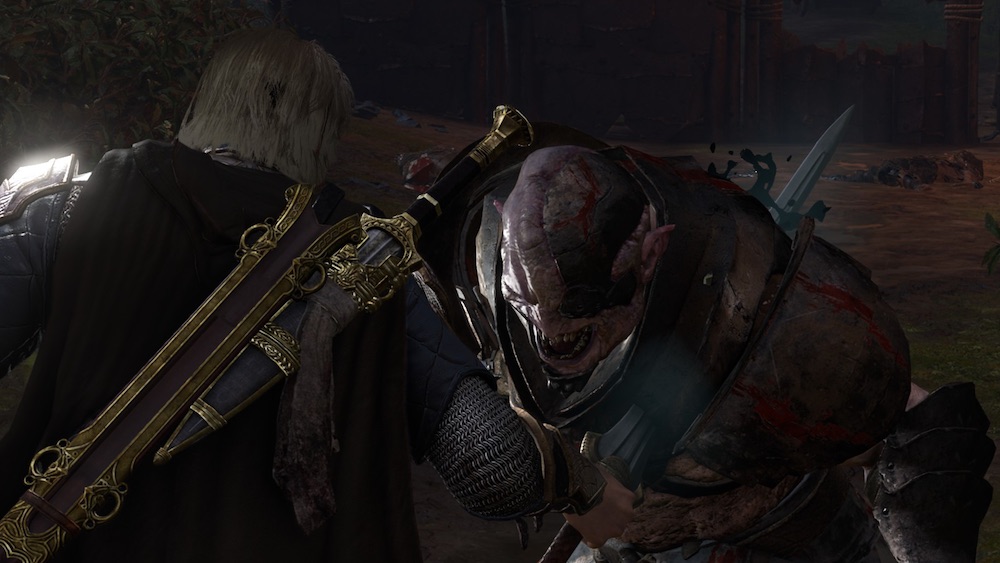
“Come on Bolg, again with the ambush? I’ve got two immolations at four and a dismembering at five and now I’m gonna be late!”
Speaking of death, you’ll be doing that a lot. It’d almost be a disservice to the game not to die because when Talion and Celebrimbor fall to the blades or arrows of some random orc, that beautiful Nemesis system swings into play and rubs that defeat in your face. The nameless minion who did you in is rewarded with a moment to brag, and after you temporarily shuffle off your mortal coil, you’re treated to a quick view of your assailant moving up the ranks of Sauron’s army. Often they’ll gain a title to their name that harkens back to your fight or to one of their strengths or weaknesses, like Bûbol the Mad, Zuka the Shy, Tâkâ the Unyielding or Hoshgrish Throat-slasher. They’ll even earn new skills by joining tribes such as the Terror, Feral or Mystic tribes. Gaining these names and affiliations, getting promoted and earning accolades such as Epic or Legendary, the Nemesis system positions these orcs more actively in your game, with repeat encounters guaranteed, especially if you’re the vengeful type and go looking for your killer the moment you come back to life. Meeting these monsters a second, third, or twentieth time is some of the best fun you’ll have in the game, as elements of your previous encounters come up in dialogue before you begin fighting and the orcs themselves change depending on how you killed them last.
I squealed with joy when I encountered a new orc named Bolg Death-Blade and made it my life’s mission to hunt him again and again. While not the Bolg I had from Shadows of Mordor, this new Bolg was a lot more fun. I can’t even remember how many times I killed him, or how many times he killed me. By the end of our struggles, he had lost an eye, both arms, both legs, most of his chest and what little flesh he had left was rotting and covered in pustules. He had even changed titles from Death-Blade to Undying to the Machine, having been rebuilt multiple times by his comrades (why!?) with awful looking jagged metal limbs. We had a lot of fun together, and it was a delight every time he showed up in an ambush, lumbering in just as I’m about to kill another captain or war chief, or appearing as a surprise addition to the ranks of defenders in a castle siege.
Now while I could sit here and talk non-stop about my adventures with Bolg the Whatever-he-is-this-time, there is a lot more to this game. Castle sieges, as I mentioned above are also a new addition to the formula, and in most respects, they work quite well. After progressing to Act Two and amassing a suitable amount of orcs to your side, you get to the siege of your first castle, and it won’t be your last either. Assembling outside the walls with your selected captains, or going it alone like a boss, you rush the place and capture a series of critical points throughout the area, fighting off hordes of orcs and captains and guys named Bolg who just don’t understand the concept of death. Making it through all these points brings you to a showdown with the overlord of that particular establishment, who you take on solo in his throne-room, along with his ever spawning reinforcements. A fair fight this is not, but triumph and the ownership shifts to you. Fail, and the douche gains a few levels, and you have to try again. It’s a fun element of the game, showing up here and there throughout the mid-game, but it’s always the same sequence with little variation on how you complete them. It’s a shame that I eventually wanted to skip these fights because they had the potential to be some of the best parts of the game if only there were a little more variety to how you complete them.
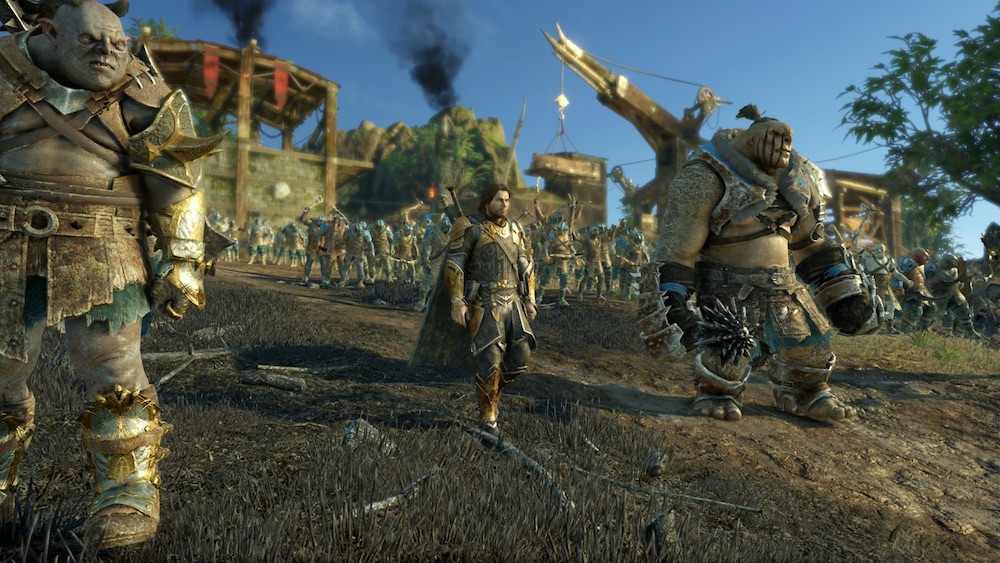
“What do we want?” “THE FORTRESS!” “When do we want it?” “Uhh…” “Guys, not again. We practiced this!”
Thankfully, the story as it progresses only has you capturing a handful of these to continue the narrative, with just a few missions locked behind sieges. It’s all worthwhile, though, as a lead-up to Act Three, which is a doozy. I’m not going to give anything away, but the entire story changes tack at this point, paying off everything up to this point and, oh man, canon or not, it blew me away. It was a bold move for the writers to go the way they did and make such a drastic change so far into a game, but they did it, and they did it well.
Then we get to Act Four and yikes, is it repetitive. After the amazingly exciting climax of Act Three, the story stalls and all you get is sieges. Ten whole waves of them to be precise, with the number of castles you have to capture or defend increasing each time. This act wouldn’t be so bad if it were just a free-play mode after the conclusion of the story, but no, it’s not. In an incredibly weak move, the real ending of the game is locked up behind these siege fights. As I had some pretty powerful orcs at my side, I was able to breeze through the first seven or eight waves rather quickly, only stumbling a bit on the last few. I finished after about ten hours, but I could easily see how a more casual player would reach a ridiculous roadblock at this point. It’s difficult, with the odds heavily stacked against you but what option do you have but to grind away at it? Well, there is one other option…
Okay, here we go, time to address the oliphaunt in the room. Your other option, especially in Act Four, but available to you at any time is Shadow of War’s marketplace. For those looking to speed through the game, you can use real-world money or the less valuable in-game currency Mirian to purchase lock-boxes that contain orcs. Why you would want to do this, I have no idea. In my opinion, buying these guys almost entirely invalidates the Nemesis system and all its benefits. You have no personal attachment to these guys. They didn’t kill you. You haven’t killed them. They haven’t saved you in some daring last-minute appearance as you were moments from death, only to betray you in the next fight. To put it in my context, they’re not Bolg! I mean, sure, some of them might come out of the boxes named Bolg, but they’re not MY Bolg, damn it!
I’m not going to get into all the noise surrounding this issue as so many others have, because I haven’t experienced it. I did my grind and got through Act Four on my own, with my captains and my Bolg, because to be clear, I never accepted the Online Terms of Use agreement at the very beginning of the game that allows me access to the marketplace. I’m not going to either. Shadow of War is a single player game, and thankfully, it didn’t prevent me from playing the game by saying no. To their credit, WB and Monolith did say that you could complete the game without buying anything and I did. Taking away from that, though, I do have to say I find it highly annoying that they present that same agreement every time I start the game, and each time I quit my save to go back to the main menu. There’s even a jarring silence when you select no, with the menu music stopping suddenly, like are you SURE you don’t want to buy stuff? Seriously, no means no, guys.
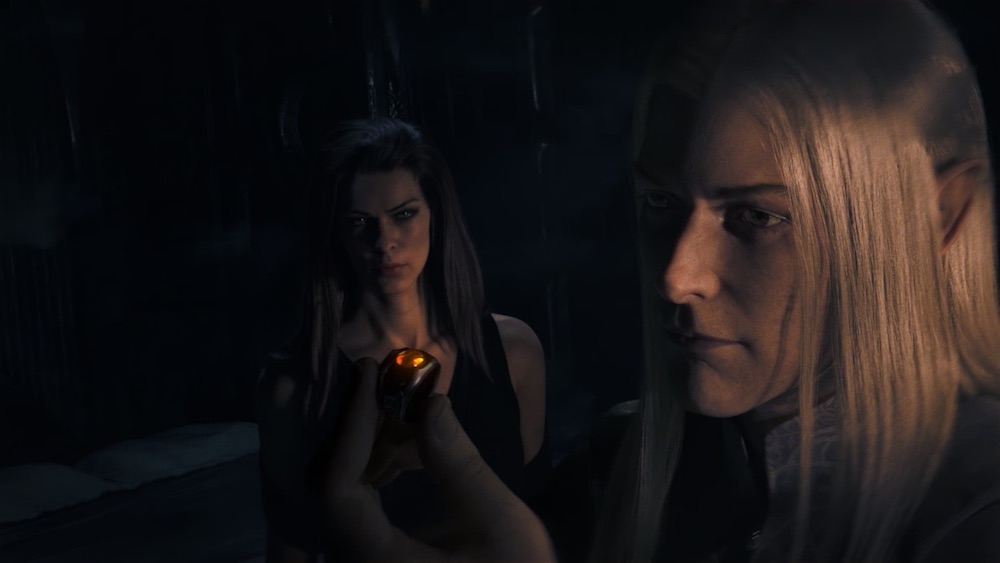
“When I said you should give people a ring sometimes, this wasn’t exactly what I had in mind.”
There’s a lot that Middle-earth Shadow of War did right that I think redeems it for the missteps it took with its marketplace or microtransactions, so not wanting to end on a negative note, I want to give a few more a shout out. Firstly, I’m one of the few who likes that Shelob the Spider transforms into a rather attractive woman in the presence of Talion. There’s a race of people from Tolkien’s extended works, the Maiar, that were shapeshifters and the game hints she might have been one, with the story going even further to show how she became the spider in the first place. It’s a fascinating expansion of the character, despite being non-canon. Secondly, we get so much more backstory on Sauron, the forging of the great rings, Celebrimbor and his involvement and so much of Middle-earth from ages past. Things hidden deep in the chapters of the Silmarillion are woven into this new story effortlessly. Thirdly, as an insatiable Tolkienite, I just love how much attention to detail there is in this world. The sounds and music are perfect. The architecture, the armour, the weapons. All the hidden collectables, codex entries and character pages are veritable gold mines of information and backstory. It’s like breakfast, second breakfast, then elevensies, and I just can’t get enough.
Finally, there is the incredibly touching tribute to Michael Forgey in the form of an in-game character known as Forthog Orc-Slayer. This burly brute will at random times intervene in your fights, usually when you’re at death’s door and save you, before disappearing again like the Mysterious Stranger from Fallout. This character is a credit to Michael, a saviour to many a project at Monolith, who sadly passed away from cancer during the development of Shadow of War. Not only is he represented by Forthog, but he also receives an emotional memorial in the credits, showing pictures of him growing from a small boy to a man, and of his time at Monolith. I’m not ashamed to say I got a bit misty for this guy I never even knew. The tribute was that well done. It’s these sort of things that need to make headlines, not some silly marketplace controversy blown out of proportion. Cast a light on the real talent and devotion that went into this game, because that’s worth mentioning.
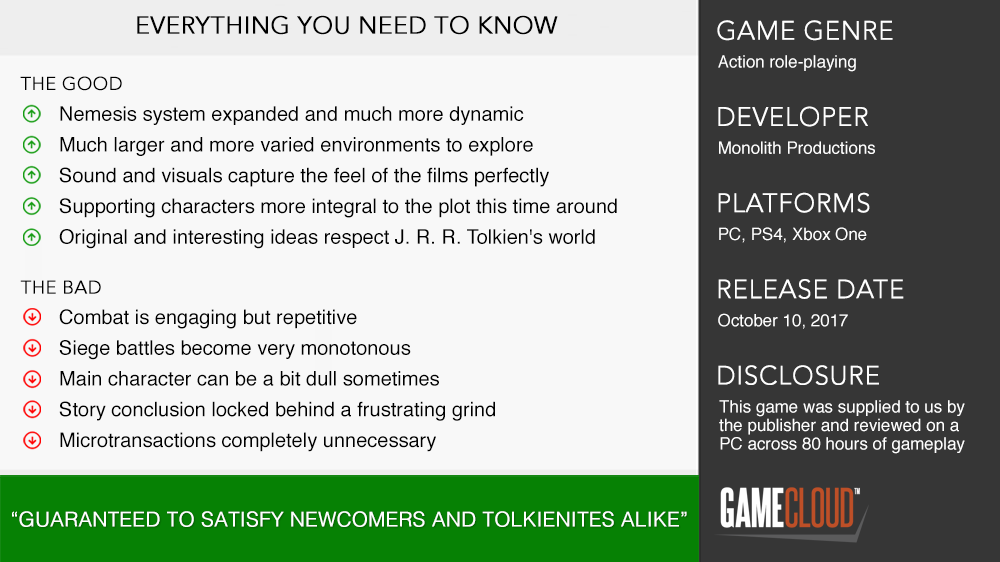
While no game is perfect, Middle-earth: Shadow of War still manages to get a lot of things right. It has its faults, sure, and the ones behind it made a few mistakes, but if you can see past that and see it for what it is at its core, I’m sure you’ll find a great adventure worthy of a few playthroughs. The improved Nemesis system is a joy to behold, and all the new places you can visit are great. Throw in a few highly cinematic fights and some fantastic attention to the history of the world, and you have a game that I’m a bit sad isn’t canon because it offers many smart and exciting additions to the story that I think might have impressed even Tolkien himself. With some DLC on the horizon and my nemesis Bolg a little overdue for his next death, it looks like I’m not done playing Shadow of War just yet.











